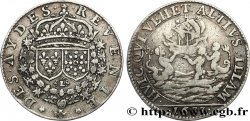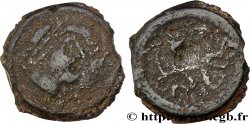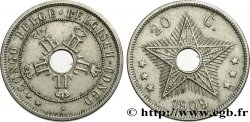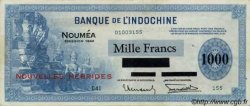v18_1435 - LUIGI XIII IL GIUSTO B. Phelypeaux, trésorier de l’Épargne 1624
MONNAIES 18 (2003)
Prezzo di inizio : 480.00 €
Valutazione : 750.00 €
lotto invenduto
Prezzo di inizio : 480.00 €
Valutazione : 750.00 €
lotto invenduto
Tipo : B. Phelypeaux, trésorier de l’Épargne
Data: 1624
Metallo : argento
Diametro : 27 mm
Asse di coniazione : 6 h.
Peso : 5,73 g.
Orlo : lisse
Grado di rarità : R3
Commenti sullo stato di conservazione:
Usure minime sur les reliefs. Superbe jeton bien centré et bien frappé, malgré l’utilisation d’un coin regravé au revers. Une patine grise recouvre cet exemplaire
N° nelle opere di riferimento :
Diritto
Titolatura diritto : * B. PHELIPEAVX. C. D ROY. EN S. C. DEST. ET. TRESR. D. S. ESPARGN.
Descrittivo diritto : Écu aux armes de Phelypeaux et de Cotereau, heaumé et lambrequiné.
Traduzione diritto : (B. Phelypeaux conseiller du roi en son conseil d’État et trésorier de son épargne).
Rovescio
Titolatura rovescio : HIS. IVVAT - IGNIBVS. VRI. ; À L'EXERGUE : .1624..
Descrittivo rovescio : Phénix sur son bûcher inscrit AEI alimenté par deux amours ; au dessus le soleil.
Traduzione rovescio : (Il lui plaît d'être consumé par ces flammes).
Commento
Millésime regravé au revers 1624 sur 1606. Très rare jeton absent des ouvrages de référence. D’après nos recherches, ce jeton apparemment inédit appartient à Balthasar Phélypeaux, seigneur d'Herbault et fils de Raymond Phélypeaux, seigneur d’Herbault (1560-1629) et de Claude Gobelin. Il est conseiller au Parlement de Paris, trésorier de l'Épargne et conseiller d'Etat. Il est mort le 15 février 1663. Le trésor de l’Épargne est la caisse principale de l’État, réorganisée en 1523 par François Ier et scindée en deux parties. Les revenus extraordinaires proviennent de la vente des offices et sont rassemblées à la recette générale des parties casuelles. Les revenus ordinaires viennent du Domaine et des impôts directs et indirects, le trésorier de l’Épargne est à la tête de cette seconde partie. Unique au départ, il est doublé d’un alternatif sous Henri II puis d’un triennal sous Henri IV. L’office coûte très cher, un million de livres en 1625 et se transmet de père en fils, sauf difficultés. Raymond Phélypeaux d’Herbault, puis Balthazar son fils dès 1621, travaillent avec Thomas Morant et Vincent Bouhier de Beaumarchais. Lieu de passage, l’Épargne collecte les recettes et règle les dépenses en suivant les rôles fournis par le Surintendant ou les acquits patents ordonnés par le souverain. Les revenus de l’office rapportent 3 deniers pour chaque livre d’argent manié. En 1661, les trésoriers de l’Épargne seront poursuivis par Colbert devant la chambre de justice. ils seront supprimés en 1664 et remplacés par les gardes du Trésor royal, commis et non officiers.
Vintage re-engraved on the reverse 1624 out of 1606. Very rare token absent from reference works. According to our research, this apparently unpublished token belongs to Balthasar Phélypeaux, lord of Herbault and son of Raymond Phélypeaux, lord of Herbault (1560-1629) and Claude Gobelin. He is an advisor to the Parliament of Paris, treasurer of Savings and State Advisor. He died on February 15, 1663. The Savings Treasury is the main fund of the State, reorganized in 1523 by François I and split into two parts. Extraordinary income comes from the sale of offices and is collected from the general receipts of casual parts. Ordinary income comes from the Estate and direct and indirect taxes, the Treasurer of Savings is at the head of this second part. Initially unique, it was doubled by an alternative under Henri II and then by a triennial under Henri IV. The office is very expensive, a million pounds in 1625, and is passed down from father to son, barring difficulties.. Raymond Phélypeaux d'Herbault, then Balthazar his son from 1621, worked with Thomas Morant and Vincent Bouhier de Beaumarchais. A place of passage, Savings collects revenue and settles expenses by following the roles provided by the Superintendent or the patent receipts ordered by the sovereign. The income from the office brings in 3 deniers for each pound of silver handled.. In 1661, the treasurers of the Savings were prosecuted by Colbert before the chamber of justice.. They were abolished in 1664 and replaced by the guards of the Royal Treasury, clerks and not officers.
Vintage re-engraved on the reverse 1624 out of 1606. Very rare token absent from reference works. According to our research, this apparently unpublished token belongs to Balthasar Phélypeaux, lord of Herbault and son of Raymond Phélypeaux, lord of Herbault (1560-1629) and Claude Gobelin. He is an advisor to the Parliament of Paris, treasurer of Savings and State Advisor. He died on February 15, 1663. The Savings Treasury is the main fund of the State, reorganized in 1523 by François I and split into two parts. Extraordinary income comes from the sale of offices and is collected from the general receipts of casual parts. Ordinary income comes from the Estate and direct and indirect taxes, the Treasurer of Savings is at the head of this second part. Initially unique, it was doubled by an alternative under Henri II and then by a triennial under Henri IV. The office is very expensive, a million pounds in 1625, and is passed down from father to son, barring difficulties.. Raymond Phélypeaux d'Herbault, then Balthazar his son from 1621, worked with Thomas Morant and Vincent Bouhier de Beaumarchais. A place of passage, Savings collects revenue and settles expenses by following the roles provided by the Superintendent or the patent receipts ordered by the sovereign. The income from the office brings in 3 deniers for each pound of silver handled.. In 1661, the treasurers of the Savings were prosecuted by Colbert before the chamber of justice.. They were abolished in 1664 and replaced by the guards of the Royal Treasury, clerks and not officers.








 Segnalare un errore
Segnalare un errore Stampate la pagina
Stampate la pagina Condividi mia selezione
Condividi mia selezione Fai una domanda
Fai una domanda Consegnare / vendere
Consegnare / vendere
 Descrittivo
Descrittivo















